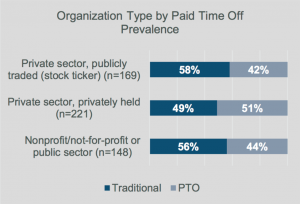
According to a new survey, employee paid time off remains a very important benefit, with organizations reporting the following three reasons for offering paid time off programs to employees:
- encouraging employees to rest and rejuvenate,
- improving employee attraction and
- satisfying employee paid time off expectations.
Eighty-eight percent of organizations believe it is necessary to offer some type of paid time off program to attract top talent and drive organizational success.
According to the survey, conducted by WorldatWork, 96 percent of participating organizations are “covered employers” under the U.S. Family and Medical Leave Act of 1993 (FMLA), meaning that they are subject to the requirements of the FMLA and must allow employees with qualifying reasons to take a specific duration of job-protected leave. A majority of companies (82%) offer job-protected leave that is mandated by the FMLA and any state/local laws. The remaining 18% of mandated organizations are more employee friendly with job security provisions for new parents, meaning that they offer job protected leave and more flexibility.
“Now more than ever, organizations are being forced to restructure their paid time off programs,” said Lenny Sanicola, WorldatWork senior practice leader. “Today, we’re seeing new paid time off laws, including parental and family leave benefits, at the local and state levels combined with more companies expanding their paid time off policies to attract employees and boost morale. Organizations understand they can no longer be competitive if they don’t get creative with their own paid time off benefits. For many employees, paid time off is more important than other traditional pay and benefits.”
Additional highlights from the 2016 survey include:
- Organizations with a traditional leave system are more likely to report higher percentages of low (0% to 5%) voluntary turnover (65%) than their PTO bank counterparts (35%).
- When organizations offer paid parental leave, 54% offer fewer than six weeks of paid leave, 16% offer six weeks and 16% offer 12 weeks. Forty-four percent require a tenure of 12 months or more before the employee can use paid parental leave.
- Of the 18% of organizations that are more employee friendly with their job protected leave provisions, the most common new-parent employees offered job-protected leave include: birth mothers (98%), biological fathers (96%) and adoptive parents (also 96%).
- At least seven in 10 organizations in either type of paid time off system offer paid time off to part-time employees.






